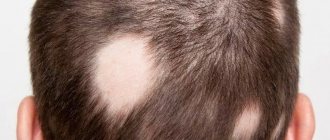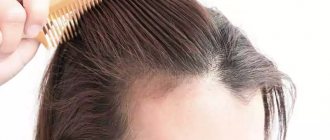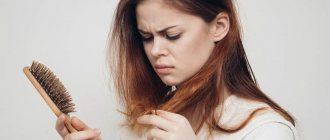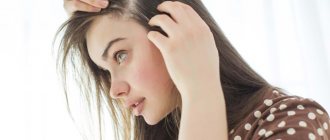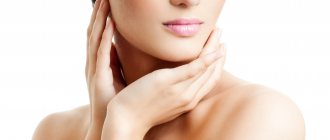Link to PubMed
Authors with positions and titles: Quan Q Dinh and Rodney Sinclair, Correspondence: Rodney Sinclair, PO Box 2900, Fitzroy 3065, Australia, Fax +613 9288 3292, Tel +613 9288 3127, Email
Imprint: Published online 2007 Jun
Less than 45% of women retain a full head of hair throughout their lives. Female pattern hair loss is the most common cause of hair loss in women and progresses with age. Women may experience psychological distress and impaired social functioning. In most cases, the diagnosis can be made clinically and treatment is carried out with medication. Many women using oral antiandrogens and topical minoxidil experience hair restoration, but early diagnosis and treatment are highly desirable as these treatments are more effective at halting the progression of hair loss than at stimulating regrowth. For some patients, additional non-drug therapies such as counseling, cosmetic camouflage, and hair transplantation are vital. Histologically, female pattern hair loss is identical to male pattern androgenetic alopecia. While clinically hereditary androgenetic alopecia varies among men, the response to topical antiandrogens suggests that most cases of female pattern androgenetic alopecia are an androgen-dependent condition. Female pattern hair loss is a chronic, progressive condition. To maintain the effect, all procedures must be constant. An initial therapeutic response often occurs after 12 or even 24 months. Given the delayed therapeutic effect, monitoring the effectiveness of treatment using clinical photographs or standardized clinical rating scales is useful. The term female androgenetic alopecia or female pattern hair loss has emerged as the preferred term for androgenetic alopecia in women due to the unclear relationship between androgens and this condition (Olsen 2001). It is characterized by a decrease in hair density on the parietal and frontal areas of the head with preservation of the frontal hair line. In 1977, Ludwig clearly described the distinctive features of female pattern hair loss and classified it into three stages of sequential diffuse hair thinning (I, II and III). The prevalence increases with age, from approximately 12% among women aged 20 to 29 years to more than 50% of women over the age of 80. Hair loss in women can cause serious psychological trauma. Cash and colleagues (1993) suggested that women place more emphasis than men on physical appearance and physical attractiveness. Social norms dictate that hair is an integral part of women's sexuality and gender identity, so any hair loss creates feelings of low self-esteem and anxiety due to a possible decrease in attractiveness. Women are more likely than men to experience reduced quality of life and limited social contacts as a result of hair loss.
Current treatments are limited, and even if the response is positive, there is a significant time delay before improvement becomes apparent. Regardless of which treatment method is chosen, sufficient time must be devoted to counseling the patient.
There are two main pharmacological therapies: antiandrogens and minoxidil. To maintain the response, both treatments must be used continuously. In some cases, non-pharmacological methods can be used: changing hairstyles, using concealing products, and hair extensions.
Treatment methods
Pharmacological
Pharmacological methods can be divided into the following: drugs with androgen-independent and androgen-dependent mechanisms of action.
Androgen-independent drugs
Minoxidil Topical minoxidil Its possible mechanism of action affects the hair growth cycle, causing premature telogen cessation, and likely prolongation of anagen. Understanding exactly how minoxidil produces these effects is currently the subject of intense research. Although the drug is available in 2% and 5% concentrations, only the 2% solution is currently approved by the FDA for the treatment of female androgenetic alopecia. A comparative study of the effectiveness of the two concentrations using hair counts in the target area over 48 weeks as the primary endpoint showed a non-significant moderate benefit for the 5% solution (Olsen et al, 2002).
Androgen-dependent drugs
The use of all androgen-dependent drugs for the treatment of female androgenetic alopecia carries a risk of developing genital abnormalities in the male fetus. Thus, these drugs are contraindicated in pregnant women, which leads many doctors to recommend that women take oral contraceptives throughout the course of treatment with these drugs. Like minoxidil, all androgen-dependent drugs must be used for at least 1 year before effectiveness can be accurately assessed.
Finasteride Finasteride Thus, finasteride inhibits total androgen activity by inhibiting the activity of total circulating androgens.
Cyproterone acetate This drug inhibits gonadotropin releasing hormone (GnRH) and blocks androgen receptors. It is also used for prostate cancer, hirsutism and severe acne. In combination with estradiol, it is used as an oral contraceptive - Diane-35.
Spironolactone Spironolactone It acts as an androgen antagonist by competitively blocking androgen receptors and also inhibits ovarian androgen production. In the United States, it is the most widely used antiandrogen for the treatment of female androgenetic alopecia. The side effects of spironolactone may be more variable than other drugs, partly due to its additive actions as an aldosterone antagonist. These include postural hypotension, electrolyte disturbances, menstrual irregularities, fatigue, urticaria, breast tenderness, and hematological disturbances.
Flutamide Flutamide It is commonly used to treat advanced prostate cancer and hirsutism. Due to the fact that the drug is one of the new antiandrogens, data on its medical use for the treatment of female androgenetic alopecia are limited. Side effects caused by flutamide are potentially serious. These include liver dysfunction, breast tenderness and are dose-dependent.
How to treat androgenetic alopecia in women?
A trichologist can determine the presence of androgenic form of baldness based on the above studies. For diagnosis, hairs are taken for examination, a series of tests are carried out to give a clear picture of the condition of the internal organs, hormonal levels are analyzed, the thyroid gland is checked, and the presence of necessary vitamins and microelements is checked.
After making a diagnosis, the doctor develops a treatment regimen. There are no universal techniques in this case: for each patient, the treatment regimen is prescribed individually. In this case, you should not self-medicate: the drugs that helped a friend may become useless for you. You need to take the medications prescribed by your doctor throughout your life, and they are not cheap. Having spent a lot of time and money on self-medication, you can miss the moment when complete baldness can still be prevented.
Treatment of androgenic alopecia in women begins after identifying the factor that triggered the onset of the disease. Complex therapy is prescribed, including medications, physiotherapy, and alternative methods (folk remedies). The exact treatment regimen depends on the stage of the disease. If less than 50% of the hair is affected, the doctor prescribes the following remedies:
- preparations with corticosteroids for external and internal use;
- gels, ointments with retinol A for treating lesions;
- immunomodulators;
- preparations with high zinc content;
- vitamin complexes with the obligatory inclusion of B vitamins.
At a more advanced stage (more than 50% of the hair is affected), the treatment regimen is different:
- preparations with corticosteroids based on hormones for external and internal use;
- antihistamine ointments;
- physiotherapy (darsonvalization, phototherapy, ozone therapy, mesotherapy);
- laser procedures;
- immunosuppressants that level autoimmune disorders;
- hormonal drugs that reduce the production of male hormones.
Only an integrated approach to the treatment of androgenetic alopecia gives good results. But it may take several months before the first signs of improvement appear. Trichologists warn their patients about this, setting them up for a long course of treatment. In some cases, the treatment regimen includes consultations with psychologists and nutritionists. Only if all doctors’ recommendations are strictly followed will the answer to the question “Can androgenetic alopecia be cured in women?” will be positive.
What medications are used to treat androgenetic alopecia in women?
All drugs used in the treatment regimen are divided into several groups.
Medication
Preparations with minoxidil.
This medicine has a good effect on the treatment of alopecia. When using it, the hair growth phase lengthens, the strands become stronger, thicker, they have shine and volume. The substance acts on the follicles, preventing hair loss. Available in the form of lotions or gels, which must be applied to damaged areas of the scalp twice a day. In the first days of use, in some cases, more severe hair loss is noticed. There is no need to be afraid of this: the drug frees the scalp of already dead hair, preparing space for new ones. After just 2-3 months of regular use, you can see new hairs appearing on the area. The strands are becoming thicker and stronger. The full effect of using the medicine can be assessed after about a year.
Finasteride.
The main effect of the drug is to suppress the enzyme responsible for the production of the hormone dihydrotestosterone, which “kills” hair follicles.
Preparations with zinc and vitamin B6
. They have a good effect on the growth and vitality of the hair.
For external use, the doctor may prescribe alcohol tinctures, which should be rubbed into the scalp. Such tinctures irritate the skin, accelerate blood circulation, the supply of nutrients to the follicles, and metabolic processes. As a result, the follicles become stronger and more productive. But not everyone can use such drugs - they are contraindicated for people with high blood pressure.
Traditional methods
Trichologists, when drawing up a treatment regimen for androgenetic alopecia in women, often supplement medications with folk remedies whose effectiveness has been verified. Among them are herbal decoctions, infusions, healing masks. But even well-functioning folk recipes cannot be used without the consent of a doctor: some herbal components may conflict with the substances included in the medicines. In this case, the effect of using medications will be reduced to zero.
When prescribing traditional medicine methods, doctors take into account the general condition of the patient. People with high blood pressure should not use products that contain red pepper, mustard, or alcohol tinctures: these substances accelerate blood flow, which leads to an exacerbation of hypertension. It is necessary to carefully approach the choice of herbal recipes for people with scalp diseases, some internal diseases, epilepsy attacks, and diabetes mellitus. Therefore, even herbal preparations and infusions must be prescribed by a doctor.
The most common folk herbs are chamomile, sage, string, and St. John's wort. Oil solutions are prepared from them for scalp massage. Among the masks, the coltsfoot mask is recommended. Nettle, burdock, and hops are used as a rinse after shampooing to improve the condition of hair strands. Hops, verbena, clover are taken in the form of infusions and decoctions externally and internally.
Physiotherapy
Ozone therapy, darsonvalization, electrophoresis, and electrical stimulation have shown the greatest effectiveness in the fight against alopecia.
If all the doctor’s recommendations are correctly followed, the treatment prognosis is positive. Although androgenetic alopecia in women cannot be completely cured, timely consultation with a doctor and a properly prescribed treatment regimen help slow down hair loss, postponing the visible consequences for a long time. If treatment does not bring results, there is a method that helps restore a beautiful appearance to the hair even if complete baldness has occurred - transplantation.
Cosmetical tools
Since changing the patient's image is the biggest problem in the development of female androgenetic alopecia, cosmetics are an integral part of the treatment. These include hair styling techniques, camouflage, hair extensions, hair accessories and additions.
Female pattern hair loss is an underappreciated condition. Significant hair loss occurs in more than ¼ of women over the age of 50. Satisfactory correction of this condition requires knowledge of the possible underlying causes, associated diseases, possible differential diagnoses, and the various therapeutic agents available. It also requires an assessment of the potential psychological impact of hair loss on the patient, as well as patients' susceptibility during consultations. Without treatment, the condition progresses. Current pharmacological treatment arrests further progression and may also stimulate partial regrowth. Regardless of the treatment method, the response is slow and requires patience and persistence from the patient and clinician. The cosmetic disadvantages of this condition should not be underestimated, and adjuvant cosmetics and surgical techniques are important additional options that should be discussed with patients as an adjunct to pharmacotherapy.
Fewer than 45% of women go through life with a full head of hair. Female pattern hair loss is the commonest cause of hair loss in women and prevalence increases with advancing age. Affected women may experience psychological distress and impaired social functioning. In most cases the diagnosis can be made clinically and the condition treated medically. While many women using oral antiandrogens and topical minoxidil will regrow some hair, early diagnosis and initiation of treatment is desirable as these treatments are more effective at arresting progression of hair loss than stimulating regrowth. Adjunctive nonpharmacological treatment modalities such as counseling, cosmetic camouflage and hair transplantation are important measures for some patients. The histology of female pattern hair loss is identical to that of male androgenetic alopecia. While the clinical pattern of the hair loss differs between men, the response to oral antiandrogens suggests that female pattern hair loss is an androgen dependent condition, at least in the majority of cases. Female pattern hair loss is a chronic progressive condition. All treatments need to be continued to maintain the effect. An initial therapeutic response often takes 12 or even 24 months. Given this delay, monitoring for treatment effect through clinical photography or standardized clinical severity scales is helpful. Female pattern hair loss (FPHL) has emerged as the preferred term for androgenetic alopecia in females owing to the uncertain relationship between androgens and this entity (Olsen 2001). It is characterized by a reduction in hair density over the crown and frontal scalp with retention of the frontal hairline. In 1977, Ludwig clearly described the distinctive features of FPHL and classified it into three grades of severity referred to as Ludwig grades I, II, and III. The prevalence increases with age from approximately 12% among women aged between 20 and 29 years to over 50% of women over the age of 80. Hair loss in women is associated with significant psychological morbidity. Cash and colleagues (1993) suggested that women place a greater emphasis than men on physical appearances and outward attractiveness. Societal norms dictate that hair is an essential part of a woman's sexuality and gender identity, and any hair loss generates feelings of low self-esteem and anxiety from a perception of diminished attractiveness. Women are more likely than men to have a lowered quality of life, and to restrict social contacts as a result of hair loss. Current management options are limited, and even in positive responders, there is a significant time delay before improvement becomes apparent. Regardless of which option is chosen, sufficient time should be spent counseling the patient.
The two main pharmacological options are antiandrogens and minoxidil. Both treatments need to be continued indefinitely to maintain a response. Nonpharmacological methods may also be appropriate in individual cases, such as changing hairstyles, camouflaging products, and hair replacement.
Collection of donor material
The procedure for a non-surgical transplant against hair loss in men begins with obtaining the transplant material. To obtain follicles, a punch needle with a thickness of 0.5-0.9 mm is used. Donor material is taken from the occipital area under anesthesia. The selection of tools is carried out taking into account the thickness of the hair, the density of the skin and other physiological characteristics.
The resulting follicles are immersed in a saline solution at a temperature of 4 degrees. After this, sorting is carried out under a microscope into:
- transplants containing one bulb;
- transplants including two bulbs;
- three-bulb grafts.
After sorting, the donor material is treated with a special solution, which enhances the survival rate of the follicles and activates hair growth after transplantation.
Treatment options
Pharmacological
Pharmacological options can be divided into drugs with androgen-independent and androgen-dependent mechanisms of action.
Androgen-independent medications
Minoxidil Currently the only androgen-independent medication in widespread use is minoxidil topical solution. This medication's proposed mechanism of action is by affecting hair cycling, causing premature termination of telogen, and probably prolonging anagen. Understanding exactly how minoxidil exerts these effects is currently the subject of intense research. Although this is available in both 2% and 5% preparations, only the 2% solution is currently FDA-approved for FPHL (DeVillez et al 1994). A study comparing the efficacy of the two concentrations using target area hair counts at 48 weeks as a primary endpoint showed a mild nonsignificant advantage for the 5% solution (Olsen et al 2002).
Androgen-dependent medications
The use of all androgen-dependent medications to treat FPHL carries a risk of causing abnormalities in the genitalia of the male fetus. , these medications are contraindicated in women who are pregnant, which leads many physicians to recommend that women start and thus remain on an oral contraceptive pill throughout their course of treatment with these medications. As with minoxidil, all androgen-dependent medications need to be continued for at least 1 year before an accurate appraisal of efficacy can be made.
Finasteride Finasteride works by inhibiting 5α-reductase II enzyme, which is responsible for catalyzing the conversion of testosterone to the much more active chemical 5 DHT. Thus, finasteride suppresses overall androgen activity by restricting total circulating androgen activity.
Cyproterone acetate This medication inhibits gonadotropin-releasing hormone (GnRH) and blocks androgen receptors. Other uses include prostate cancer, hirsutism, and severe acne. Is commonly used combined with estradiol as an oral contraceptive pill named Diane-35.
Spironolactone Spironolactone is used widely to treat FPHL and hirsutism. It acts as an androgen antagonist by competitively blocking androgen receptors, as well as inhibiting ovarian androgen production. In the USA it is the most widely used antiandrogen to treat FPHL.
The side effect profile of spironolactone is perhaps more varied compared with other medications, due partly to its additional actions as an aldosterone antagonist. These include postural hypotension, electrolyte disturbances, menstrual irregularities, fatigue, urticaria, breast tenderness, and hematological disturbances.
Flutamide Flutamide is a potent antiandrogen, acting via androgen receptor antagonism. As such, it is commonly used to treat advanced prostate cancer and hirsutism. Being one of the newer antiandrogens, there is limited medical literature on its use in FPHL. Adverse effects due to flutamide are potentially severe. These include hepatic dysfunction and breast tenderness, both of which are dose-related.
Causes of the disease
There are quite a few reasons, they are determined depending on the type of alopecia.
These may be external factors, the consequences of diseases, deficiencies, as well as heredity. Unfortunately, there are also incompletely studied causes of the disease, but even they are treatable.
Main causes of the disease:
heredity
· deficiency of vitamins, minerals
· postpartum period, lactation period, menopause period
· previous diseases (endocrine, autoimmune, skin)
· intoxication (antibiotics and other medications, chemicals, poisons)
· stress and shock conditions
· antitumor therapies
· injuries (various types of burns, frostbite, wounds)
Cosmetic aids
Since so much of the morbidity of FPHL lies in body image disturbances, cosmetic aids are an integral part of management options. These incorporate hair styling techniques, camouflage products, hair replacements, hair accessories, and additions.
FPHL is an under-recognized entity. Significant hair loss is seen in over ¼ of females over the age of 50. Satisfactory management of this condition requires a knowledge of possible underlying causes, physical comorbidities, possible differential diagnoses, and the various therapeutic modalities available. It also requires an appreciation of the potential psychological effect of hair loss on affected individuals, and sensitivity during patient consultations.
The condition is progressive without treatment. Current pharmacological treatment stems further progression and can also stimulate partial regrowth.
Regardless of which medication is utilized, the response is slow, and requires patience and persistence in both patient and clinician. The cosmetic effects of this condition should not be underestimated, thus cosmetic aids and surgical options are both important adjunctive options that need to be discussed with these patients in addition to pharmacotherapy.
